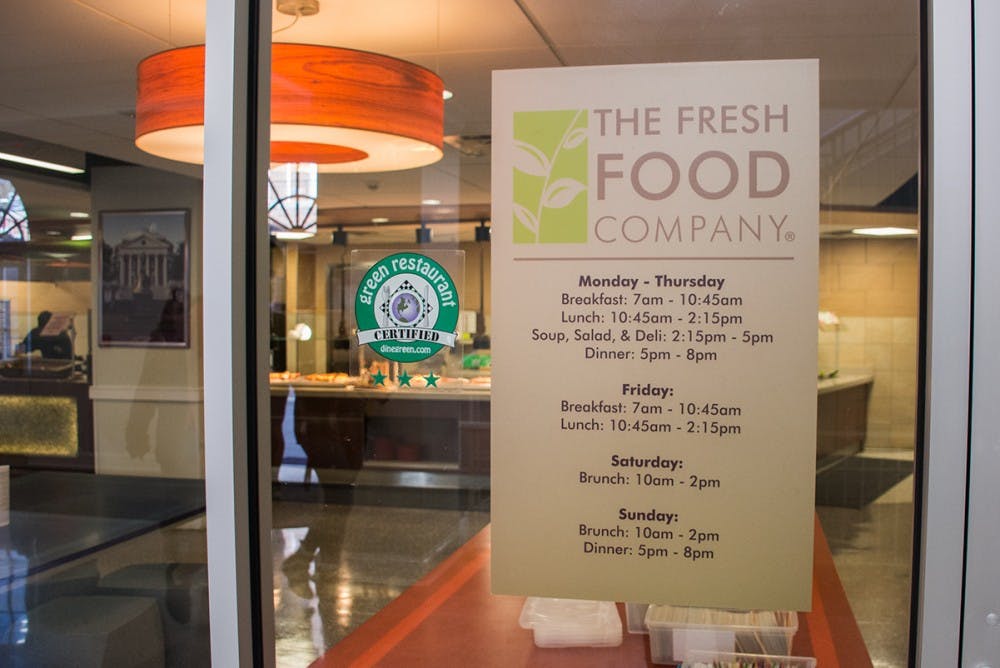There is little doubt that Aramark leaves much room for improvement concerning its partnership with U.Va. Dining. Most recently, dining facilities at the University were found to have incurred 86 health code violations over 2017, including 43 “priority” violations. These health violations are indicative of Aramark’s general disregard for food safety in the past — from serving prisoners reheated trash to failing to meet state health standards. Notwithstanding all of the ethical complaints that Aramark has faced in the past, there is at least one field in which Aramark can improve in serving the University community — correcting the inaccurate or nonexistent information provided to students regarding nutritional information.
Although nutritional facts for foods can be looked up on the U.Va. Dining website, the website itself has its own problems. In terms of design, the site poses accessibility problems with first-time users. Switching between breakfast, lunch and dinner menus is limited exclusively to clicking on text rather than the entire button which the text lies on. Additionally, the “View Selected Items” and “Clear Selected” options — which are prominently displayed directly below the mealtime divider — redirect the user to the site’s “meal calculator.” However, the site’s meal calculator requires users to pre-select items from lists which are, by default, collapsed. The option to expand these lists at once, however, is displayed in a far less prominent manner, with no different-colored background to stand out from the site’s background color. In fact, the option to “View Selected Items” and “Clear Selected” are entirely redundant; the site’s sidebar already contains those options, making the inclusion of these distracting elements questionable.
In terms of content, the site has inconsistent food titles, alternating between standard menu items and a strangely-labeled “AF” series of foods. In addition, the site entirely omits nutritional labels from certain items — the red-skin potato salad, for example. The site does itself no favors with its search function; searching for “fajita” on the site displays redundant results, like the inclusion of “Chicken Fajita Pizza” four times. The search function, incredibly enough, displays entirely deprecated results, such as “Chicken Fajita Pizza — DO NOT USE.” Issues in design and content make the U.Va. Dining website an unreliable source at best, meaning that students must rely on nutritional labels provided at dining premises. Food labeling at U.Va. Dining facilities, however, faces three issues: labels provided at dining halls may be completely nonexistent, inconsistent with one another or simply misleading. Given Aramark’s supposed commitment towards healthy eating at the University, its inability to provide important nutritional information both online and in-person only serves to undermine that goal.
Admittedly, the issue of nonexistent nutrition labels is usually constrained to a limited number of items per day. However, there lies the problem that provided nutritional labels are inconsistent with one another or at times outright misleading. Nutritional labels concerning constructed items such as cheeseburgers, fajitas, etc. often contain nutritional information which assumes that the user takes a certain combination of items — for instance, the chicken fajita assumes that students are including cheese, sour cream, salsa and flour tortillas, which are all completely optional elements in their meal. A better solution to this would be to include core elements, which in this case would just be the chicken and vegetable mixture in nutritional labels, and splitting all the optional elements with seperate nutritional labels.
Considering all of the ethical and health issues which Aramark has faced in the past, raising complaints regarding the corporation’s handling of nutritional labels seems benign in comparison. Yet, it is one field which Aramark can be expected to improve within a reasonably short period of time compared to some of Aramark’s more egregious violations of food safety. Given the United States’ ever-rising obesity rates — which poses a threat to national security and incurs billions in healthcare costs each year — taking any efforts to improve health awareness, such as through accurate nutritional labeling, would prove to be beneficial for students and society as a whole. Additionally, accurately labeling food listings would provide an additional layer of security for those with food allergies or intolerances, improving the safety of the University’s dining halls.
William Wong is an Opinion columnist for The Cavalier Daily. He can be reached at opinion@cavalierdaily.com.







